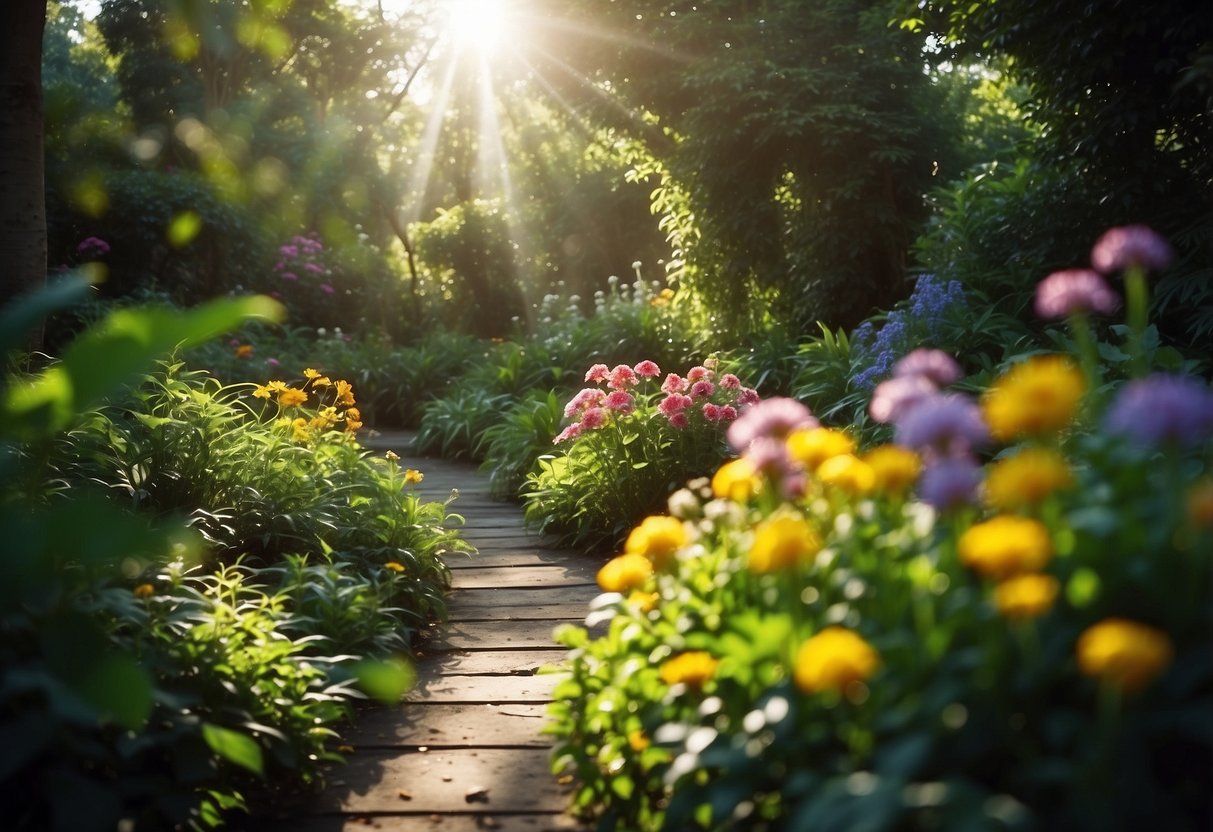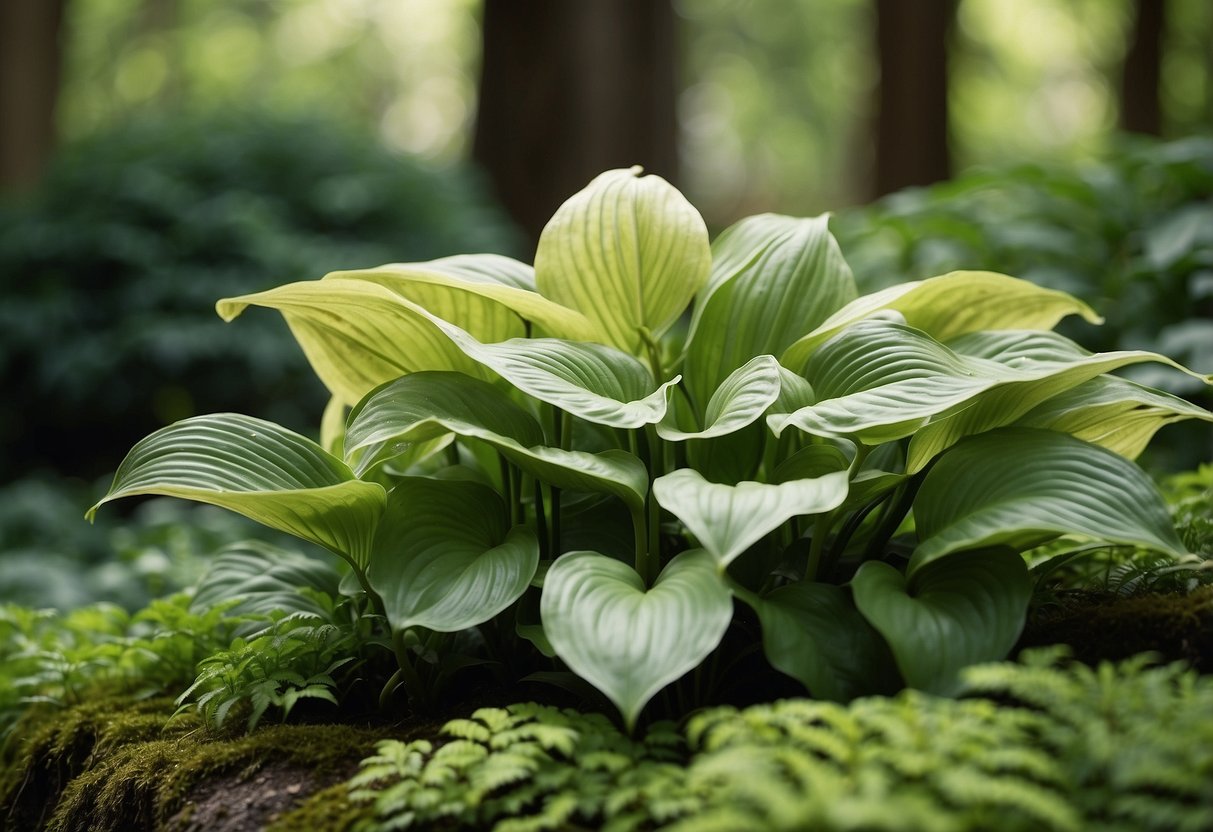Garden Ideas for Dark Corners: Brighten Up Shady Spaces
Gardening can be a joyful and creative activity, but dealing with the shady, dark corners of your garden can sometimes be a challenge. These areas often get overlooked, yet they offer a unique opportunity to add character and serenity to your outdoor space. Discovering how to transform these dim spots can make your entire garden feel more inviting and complete.

You don’t need to be an expert gardener to turn a dark corner into a beautiful part of your yard. Some clever ideas and the right plants can make a big difference. Enhancing these shadowy areas not only boosts the aesthetics of your garden but also maximizes your use of space.
1) Hosta ‘Sum and Substance’

If you have a dark corner in your garden, Hosta ‘Sum and Substance’ can brighten it up.
This plant is known for its large, broad leaves that can reach up to 20 inches long. The leaves change color based on sun exposure, ranging from light green to gold.
This hosta grows best with partial sunlight and needs room to spread, often reaching up to five feet wide and three feet tall.
2) Ferns

Ferns are perfect for those dark corners in your garden. They love shade and add a touch of elegance with their lush, green fronds. Ferns like the Lady Fern or Cinnamon Fern can thrive in these spots.
You can even create an under-tree fernery, enhancing your garden’s aesthetic with their textured elegance. Try planting ferns like the Soft Tree Fern to create a beautiful canopy in shady areas.
3) Japanese Forest Grass

Japanese Forest Grass, also known as Hakonechloa macra, is perfect for shaded garden spots. Its flowing, bamboo-like stalks bring a soft, graceful look.
This grass thrives in partial shade and prefers moist soil. Make sure to water it about three times a week.
Plant it near paths or around garden beds. Its bright green leaves will lighten up dark corners beautifully.
Consider the Nicolas variety for a striking, non-variegated option.
4) Liriope

Liriope is a great choice for dark corners in your garden. This plant is known for its toughness and ability to thrive in shady spots.
You can plant liriope as a border or even use it for mass planting. It requires little care, making it perfect for busy gardeners.
Space the plants 12 to 18 inches apart for borders and around 24 inches apart for larger areas. Liriope doesn’t need much fertilizer, so just add some compost to keep it happy and healthy.
5) Astilbe

Astilbe is a fantastic choice for dark corners in your garden. This perennial shines with its feathery plumes that come in shades of pink, purple, and white.
Astilbes love the shade and need moist soil to thrive. They can grow in USDA zones 3 to 9, making them versatile for various climates.
Plant Astilbes in groups to create eye-catching borders or edges in your garden. Their uniform growth adds structure and elegance, giving your dark corners a splash of color and life. For more information on using Astilbe, visit Gardenista’s guide.
6) Hakonechloa

Hakonechloa, also known as Japanese forest grass, is a stunning choice for dark corners in your garden. It thrives in shaded areas and adds a lovely visual appeal with its flowing, bamboo-like stalks.
This ornamental grass grows 12 to 18 inches tall and creates a cascading effect. It is perfect for filling in spaces under trees or along paths.
For the best results, plant your Hakonechloa in well-drained soil and keep the environment evenly moist. This grass is also low-maintenance, making it a great addition to any garden. Learn more about Hakonechloa here.
7) Foamflower

Foamflower is a perfect choice for adding charm to dark garden corners. Its star-shaped blooms look like little pieces of foam, creating a whimsical display.
This plant thrives in shady areas, making it a go-to for spots with low light. Besides its pretty flowers, the leaves often have interesting patterns or veins, adding visual appeal throughout the growing season.
For more information about Foamflower, check out this guide on the Foam Flower.
8) Snowdrops

Snowdrops are perfect for dark corners in your garden. These tiny, white flowers pop through the snow in late winter and early spring. They thrive in light shade and moist soil.
Plant them in groups to create a beautiful blanket of white. Snowdrops also naturalize well, spreading and returning year after year. For more information, check out shade garden tips.
9) Brunnera ‘Jack Frost’

Brunnera ‘Jack Frost’ is great for brightening up dark corners in your garden. Its large, heart-shaped leaves are silver with green veins, which make the plant look like it’s glowing.
This plant grows well in shady, cool spots. It prefers moist soil but can handle some dryness. It’s also hardy in zones 3 through 8.
Clusters of small, pale blue flowers appear in spring, adding even more color to your shady areas. For a cohesive look, plant it in masses or mix it with other white and silver plants for a stunning effect.
You can learn more about the features and care tips by visiting Gardenia.
10) Bleeding Heart

Bleeding Heart is a lovely choice for dark corners in your garden. These delicate flowers thrive in shaded areas, adding a touch of romance with their heart-shaped blooms.
The plant does well in partial to full shade and prefers well-drained soil. You can find various types, such as the Amore Pink, which grows in clumps and can reach 14 inches tall.
For extra charm, try planting them under shade trees or in woodland gardens, where their pink and white flowers can brighten up the space.
Understanding Light Levels

Understanding the light levels in your garden is crucial for successful planting. Each plant thrives under specific conditions, and grasping these can make your shaded garden bloom.
Types of Shade
In assessing your garden’s light levels, it’s helpful to know the types of shade. Full shade means no direct sunlight reaches the area, often found under dense tree canopies. Partial shade receives around 3-6 hours of sun, such as areas near walls that get morning sun but afternoon shade. Dappled shade occurs when sunlight filters through tree leaves, creating a speckled light effect. Recognizing these distinctions helps you pick the right plants that can flourish under specific shade conditions.
| Type | Description |
|---|---|
| Full Shade | No direct sunlight, often under dense trees |
| Partial Shade | 3-6 hours of sun, usually morning or late afternoon |
| Dappled Shade | Filtered sunlight through tree leaves |
Assessing Your Garden’s Light
To figure out your garden’s light, watch the sun’s path. Stand in different spots throughout the day and note how long each area gets sun. For more accuracy, use a light meter. Write down these observations, categorizing spots into full shade, partial shade, or dappled shade.
Create a simple map of your garden. Mark sunny and shady spots. This map helps you decide where to plant. Artificial light levels from nearby houses or streetlights can also affect your garden, so take note of those, too.
Understanding these factors helps you create a better garden layout and choose plants that will thrive.
Plant Selection for Dark Corners

Filling dark corners of your garden with the right plants can bring life and color to these often overlooked spaces. In this section, you will learn about various plants that thrive in the shade, adding beauty through their foliage and unique textures.
Shade-Tolerant Plants
When dealing with dark corners, it’s essential to choose shade-tolerant plants. Some great options include Hostas, which are known for their large, leafy appearance and can withstand heavy shade. Ferns, like the Polypodium cambricum, are also ideal for shady areas with their bright green fronds that look like tiny fir trees.
Consider planting Campanula for its delicate, bell-shaped flowers that come in blue, purple, or white. These can drape beautifully over rocks and walls. Astilbe is another excellent choice, producing plumes of red, pink, or white flowers that add vertical interest.
Bleeding Heart and Coral Bells are perennials that can add color without needing much sunlight. They both have unique, eye-catching blooms that can brighten any dark spot.
Colorful Foliage Options
Colorful foliage adds visual interest even when flowers aren’t in bloom. Heuchera (Coral Bells) comes in various shades of red, bronze, and purple, perfect for adding a pop of color. Hostas also offer a range of foliage colors, from deep blue-green to chartreuse, providing contrast and depth.
Another great option is Caladium, known for its vibrant leaves in shades of pink, red, and white. Coleus is also a standout, with its multicolored leaves that can handle low light conditions. Japanese Painted Fern delivers a beautiful silver and purple hue, making it a striking addition to any shaded area.
For more texture, try Brunnera, which has heart-shaped leaves with white or silver markings. Its bright green foliage is a great way to add a splash of brightness to dark spots in your garden.
Texture and Form
In shaded gardens, texture and form are crucial for creating visual interest. Ferns offer fine, feathery textures that contrast well with broader leaves. Hostas bring large, bold foliage which can be layered to add depth. Hakonechloa (Japanese Forest Grass) has a graceful, arching form that brings movement and elegance.
The Bleeding Heart plant’s delicate, heart-shaped flowers add both texture and a unique form. Lungwort has spotted leaves and adds a soft, silvery texture.
Lastly, Solomon’s Seal with its arching stems and dangling white flowers, adds both vertical and horizontal interest, creating a more dynamic look in shaded corners.
Design Tips and Ideas

Exploring ways to brighten dark corners in your garden includes creating focal points, utilizing containers, and adding garden art. These ideas will help transform those often overlooked spaces into vibrant areas.
Creating Focal Points
To make a dark corner stand out, focus on creating a focal point. Use a unique feature to draw the eye, like a small water fountain or a colorful sculpture. Brightly colored plants such as begonias or astilbes can also work well.
Lighting enhances focal points. Consider adding solar lights or lanterns to highlight key areas and bring warmth. Using different heights adds interest, so mix tall shrubs with low-lying ground covers.
Using Containers
Containers are versatile and perfect for shaded corners. They allow you to move plants around easily and experiment with different arrangements. Use pots of varying sizes and colors to add depth and visual interest.
Select shade-loving plants like ferns, hostas, and heucheras. These plants thrive in low light and add lush greenery. Self-watering containers can help maintain moisture, ensuring plants stay healthy.
Incorporating Garden Art
Adding garden art helps personalize dark corners. Consider items like wind chimes, decorative stones, or even a birdbath. Each piece should reflect your style and provide a talking point.
Mirrors can be used to reflect light and make small spaces feel larger. Hang them on walls or fences to double the impact. Use whimsical elements like fairy houses or gnomes to create a playful atmosphere.







